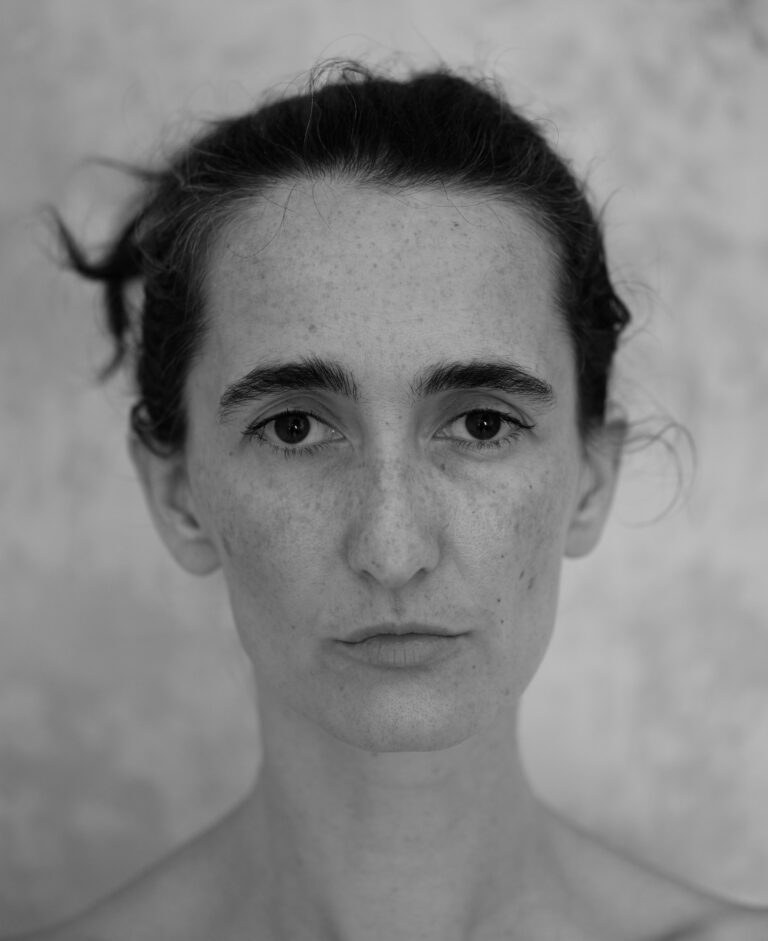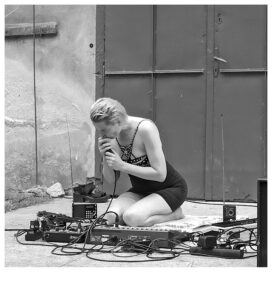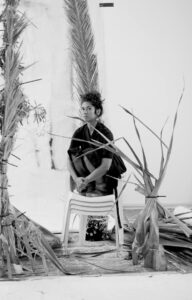Hajnalka Tarr

– born in 1977, Budapest – graduated from the painting department of the Hungarian University of Fine Arts in 2006. She lives and works in Budapest. She has been interested in the visual manifestation of reality since the beginnings of her artistic practice, which mainly unfolds in the genre of drawing, installation and photo-based works. Tarr’s works are mostly process based, the methods she uses are repetitive and time consuming. Having emerged in the neo-conceptual environment of Hungary in the late nineties, her sensual creative praxis merges intellectual distance with the claim of self-exposure. Her artistic research always stands for the manner how an individual relates to the world surrounding them.
Black hole
My artist statement is the physical analogy of Stephen Hawking’s black hole hypothesis: the internal particles of the material composing objects that fall into a black hole collapse completely, lose their substance, change their properties. That is, the paradoxical situation that arises is the following; if one would get into such a gravitational tunnel, one’s body would still remain a coherent whole even though its cells and atoms would disintegrate in the abovementioned way. Therefore, at the moment of annihilation, the body still remains formally self-identical. In this gravitational tunnel, I examine the tunnel itself as an artist and my own materiality as a tissue structure in it, as it changes and as everything that I have named dies in it123.
All my works are made with a meticulous, repetitive practice. Not only do the uniformity and multiplicity of the elements composing the work repeat themselves, but also the sequences of movements in the making of the work itself. The process is time consuming. Demolition and rearrangement. If the world of phenomena is constantly transformed, if we constantly lose it in the way we understand and experience it at a given moment, then at least this disintegration should take place between my hands and I could be actively present in its reconstruction. I worked with the pieces of a puzzle, 700,000 paper clips, and cut up photos of myself and then stitched them together. For the past year, I have been making glass mosaics in which I cut out photos of myself and rearrange them into a new image based on different repetition patterns of the elements45. In the process during which the image disintegrates, then rebuilds into a new version, one can experience the difficult-to-tolerate state of transitoriness in which things cannot be accurately identified.
During this time-consuming working process, the stress caused by the state of transition becomes a kind of normality in which the unidentifiable becomes a permanent, secure environment678.
Continuous completed present: every moment is just being created, present and passing on the same point. It is through my own perceptions, feelings, and thoughts — as individual imprints of an ever-changing reality — that I examine this constant transitoriness. I see my artistic practice – an external branch of my nervous system – as a mechanism processing information in which the images and objects created are the products of the process of understanding, but can also be incidentally interpreted as art. I try to capture its „changing” forms, faces and formulas, whatever point I am starting from91011.
I dealt a lot with Buddhism. The preliminary practice of all four schools of Buddhism is the Ngöndro, which includes 4 practices in itself, meaning 111,111 repetitions per practice. My artistic practice is mostly related to the third practice: the so-called “mandala offering”. According to a given method (text and sequence of movements), the practitioners hold a pile of rice weighing several kilos mixed with semi-precious stones on their lap, and drizzle 27, then 7 piles of it from their hand on the top of the mandala drum. As they repeat this absolute universe, they say a related sentence in Sanskrit. Then they sweep the 7 built-up piles off the drum in one go and rebuild it for 111,111 times. When they are done with this, they can move from this third basic practice to the fourth. My artistic practice is like spending my whole life in this practice. The artistic practice and the objects resulting from it are secondary.
I work with plywood, nails, industrial raw materials. My operations are basic, they don’t require artistic talent, just focus and time, patience and work. I think development is not a sublime thing, development is profane and an activity requiring daily work121314.
This statement was edited in collaboration with curator Fanni Magyar (2021).
1Image: Hajnalka Tarr, In Vitro XXIV, 2020, giclée print, glass mosaic, collage mounted on Dibond, 135 x 123 cm. Courtesy of the artist and acb Gallery, Budapest.2Image: Hajnalka Tarr, In Vitro XII, 2020, giclée print, glass mosaic, collage mounted on Dibond, 159 x 123 cm. Courtesy of the artist and acb Gallery, Budapest.
3Image: Hajnalka Tarr, In Vitro SZR3, 2020, giclée print, glass mosaic, collage mounted on Dibond, 93 x 120 cm. Courtesy of the artist and acb Gallery, Budapest.
4Image: Hajnalka Tarr, The Big Plane Holder, 2018, giclée print, weaving, 90 x 110 cm. Courtesy of the artist and acb Gallery, Budapest.
5Image: Hajnalka Tarr, Torso I, 2018, giclée print, weaving, 90 x 80 cm. Courtesy of the artist and acb Gallery, Budapest.
6Image: Hajnalka Tarr, In Vitro XV, 2020, giclée print, glass mosaic, collage mounted on Dibond, 156 x 147 cm. Courtesy of the artist and acb Gallery, Budapest.
7Image: Hajnalka Tarr, In Vitro XVI, 2020, giclée print, glass mosaic, collage mounted on Dibond, 156 x 147 cm. Courtesy of the artist and acb Gallery, Budapest.
8Image: Hajnalka Tarr, In Vitro XVII, 2020, giclée print, glass mosaic, collage mounted on Dibond, 156 x 147 cm. Courtesy of the artist and acb Gallery, Budapest.
9Image: Hajnalka Tarr, In Vitro VIII, 2020, giclée print, glass mosaic, collage mounted on Dibond, 147 x 102 cm. Courtesy of the artist and acb Gallery, Budapest.
10Image: Hajnalka Tarr, In Vitro XIX, 2020, giclée print, glass mosaic, collage mounted on Dibond, 174 x 147 cm.
11Image: Hajnalka Tarr, In Vitro XVIII, 2020, giclée print, glass mosaic, collage mounted on Dibond, 174 x 147 cm. Courtesy of the artist and acb Gallery, Budapest.
12Image: Hajnalka Tarr, Object Relations 12, 2018, giclée print, weaving, 56 x 73 cm. Courtesy of the artist and acb Gallery, Budapest.
13Image: Hajnalka Tarr, Object Relations 22, 2018, giclée print, weaving, 56 x 73 cm. Courtesy of the artist and acb Gallery, Budapest.
14Image: Hajnalka Tarr, In Vitro XXII, 2020, giclée print, glass mosaic, collage mounted on Dibond, 123 x 135 cm. Courtesy of the artist and acb Gallery, Budapest.
– szül. 1977, Budapest – a Magyar Képzőművészeti Egyetem festő szakán diplomázott 2006-ban. Budapesten él és dolgozik. Rajzaiban, installációiban és fotó alapú munkáiban már pályája kezdete óta a valóság vizuális manifesztációjával foglalkozik. Tarr munkái folyamat alapúak, munkamódszere gyakran repetitív és időigényes. A késő kilencvenes évek neokonceptuális közegében kibontakozó installatív, szenzuális alkotói gyakorlatában az intellektuális távolságtartás a feltárulkozás igényével találkozik. Művészeti kutatásai az individuum viszonyát járja körül az őt körülvevő világhoz.
Fekete lyuk
Artist statementem fizikai analógiája Stephen Hawking fekete lyuk hipotézise: a fekete lyukba zuhanó tárgyak anyagának belső részecskéi teljesen összeomlanak, elveszítik tartásukat, megváltoztatják tulajdonságukat. Vagyis az a paradox helyzet áll elő, hogy ha esetleg bármelyikünk bekerülne egy ilyen gravitációs kürtőbe, ugyan a sejtjei-atomjai az említett módon porlanának szét, a teste mégis koherens egységben maradna. A megsemmisülés pillanatában tehát a test formailag mégis önazonos marad. Ebben a gravitatív kürtőben művészként a kürtő és abban a saját anyagszerűségemet vizsgálom, mint szövetszerkezetet, ahogyan változik, ahogyan halálnak halálával hal meg benne minden annak, aminek éppen megneveztem123.
Minden munkám aprólékos, repetitív munkamódszerrel készül. Nem csak a munkát felépítő elemek egyformasága és sokasága, de maga a munka elkészítésében a mozdulatsorok is ismétlődnek. A folyamat időigényes. Bontás és újrarendezés. Ha már a jelenségvilág konstansan átformálódik, vagyis folytonosan elveszítjük annak, aminek adott pillanatban értjük, tapasztaljuk, akkor legalább a kezeim között történjen ez a szétbomlás és aktívan jelen lehessek újraalakulásánál. Dolgoztam puzzle-lel, 700.000 gémkapoccsal, vagy saját magamról készült fotókat vágtam fel, majd fűztem össze. Az elmúlt egy évben olyan üvegmozaikokat készítek, amelyekben saját magamról készített fotókat vágok fel, majd ezeket új képpé rendezem az elemek különböző ismétlődése alapján45. A kép szétbomlása majd új verzióvá épülése során lezajló folyamatban közvetlenül megtapasztalható az átmenetiségnek az a nehezen elviselhető állapotba, amelyben a dolgokat nem tudjuk pontosan beazonosítani. Az időigényes munkafolyamat során az átmeneti állapot okozta feszültség egyfajta normalitássá válik, amelyben a nem beazonosítható válik az állandó, biztos környezetté678.
Folyamatos befejezett jelen: minden pillanat éppen keletkezik, van és elmúlik egyazon ponton. Saját percepcióimon, érzéseimen és gondolataimon – mint a folyton változó valóság egyéni lenyomatain – keresztül ezt az állandó átmenetiséget vizsgálom. Művészeti tevékenységemre – mint az idegrendszerem külső leányvállalatára – egy olyan információfeldolgozó mechanizmusként tekintek, amelyben a létrehozott képek és tárgyak a megértés folyamatának termékei, mellékesen azonban művészetként is értelmezhetők. A „változó“ formáit, arcait, képleteit próbálom megragadni bármely pontból is induljak91011.
Sokat foglalkoztam buddhizmussal. A buddhizmus mind a négy iskolájának előkészítő gyakorlata a Ngöndro, ami 4 gyakorlatot foglal magában, ez gyakorlatonként 111.111 ismétlést jelent. A művészeti praxisom leginkább a harmadik gyakorlathoz köthető: ún. „mandala felajánlás“-hoz. A gyakorló egy megadott módszer szerint (szöveg és mozdulatsor) színes, féldrágakövekkel vegyes több kiló rizs halmot tart az ölében és abból 27, illetve 7 kupacot szór a markából a mandala dob tetejére. Miközben ezt az abszolút univerzumot ismétli, elmond egy ehhez kapcsolatos mondatot szanszkritul. A felépített 7 halmot utána egy mozdulattal lesöpri a dobról, majd újra építi mindezt 111.111 alkalommal. Amikor ezzel készen van, a 3. alapgyakorlatról a negyedikre léphet. A művészeti praxisom olyan, mintha az egész életemet ebben a gyakorlatban tölteném. A művészeti praxis és a velejáró tárgyak másodlagosak.
Dolgozom rétegeltlemezzel, szögekkel, indusztriális alapanyagokkal. A műveleteim alapvetők, nem igényelnek művészeti tehetséget csak fókuszt és időt, türelmet és munkát. Azt gondolom a fejlődés nem magasztos dolog, a fejlődés profán és napi munkával járó tevékenység121213.
A statement Tarr Hajnalka és Magyar Fanni kurátor együttműködésébenjött létre (2021).
1Kép: Tarr Hajnalka, In Vitro XXIV., 2020, giclée print, üveg mozaik, kollázs Dibondra kasírozva, 135 x 123 cm. A művész és az acb galéria jóvoltából.2Kép: Tarr Hajnalka, In Vitro XII., 2020, giclée print, üveg mozaik, kollázs Dibondra kasírozva, 159 x 123 cm. A művész és az acb galéria jóvoltából.
3Kép: Tarr Hajnalka, In Vitro SZR3, 2020, giclée print, üveg mozaik, kollázs Dibondra kasírozva, 93 x 120 cm. A művész és az acb galéria jóvoltából.
4Kép: Tarr Hajnalka, A nagy síktartó, 2018, giclée print, szövés, 90 x 110 cm. A művész és az acb galéria jóvoltából.
5Kép: Tarr Hajnalka, Torzó I., 2018, giclée print, szövés, 90 x 80 cm. A művész és az acb galéria jóvoltából.
6Kép: Tarr Hajnalka, In Vitro XV., 2020, giclée print, üveg mozaik, kollázs Dibondra kasírozva, 156 x 147 cm. A művész és az acb galéria jóvoltából.
7Kép: Tarr Hajnalka, In Vitro XVI., 2020, giclée print, üveg mozaik, kollázs Dibondra kasírozva, 156 x 147 cm. A művész és az acb galéria jóvoltából.
8Kép: Tarr Hajnalka, In Vitro XVII., 2020, giclée print, üveg mozaik, kollázs Dibondra kasírozva, 156 x 147 cm. A művész és az acb galéria jóvoltából.
9Kép: Tarr Hajnalka, In Vitro VIII., 2020, giclée print, üveg mozaik, kollázs Dibondra kasírozva, 147 x 102 cm. A művész és az acb galéria jóvoltából.
10Kép: Tarr Hajnalka, In Vitro XIX., 2020, giclée print, üveg mozaik, kollázs Dibondra kasírozva, 174 x 147 cm. A művész és az acb galéria jóvoltából.
11Kép: Tarr Hajnalka, In Vitro XVIII., 2020, giclée print, üveg mozaik, kollázs Dibondra kasírozva, 174 x 147 cm. A művész és az acb galéria jóvoltából.
12Kép: Tarr Hajnalka, Tárgykapcsolat 12, 2018, giclée print, szövés, 56 x 73 cm. A művész és az acb galéria jóvoltából.
13Kép: Tarr Hajnalka, Tárgykapcsolat 22, 2018, giclée print, szövés, 56 x 73 cm. A művész és az acb galéria jóvoltából.
14Kép: Tarr Hajnalka, In Vitro XXII., 2020, giclée print, üveg mozaik, kollázs Dibondra kasírozva, 123 x 135 cm. A művész és az acb galéria jóvoltából.



